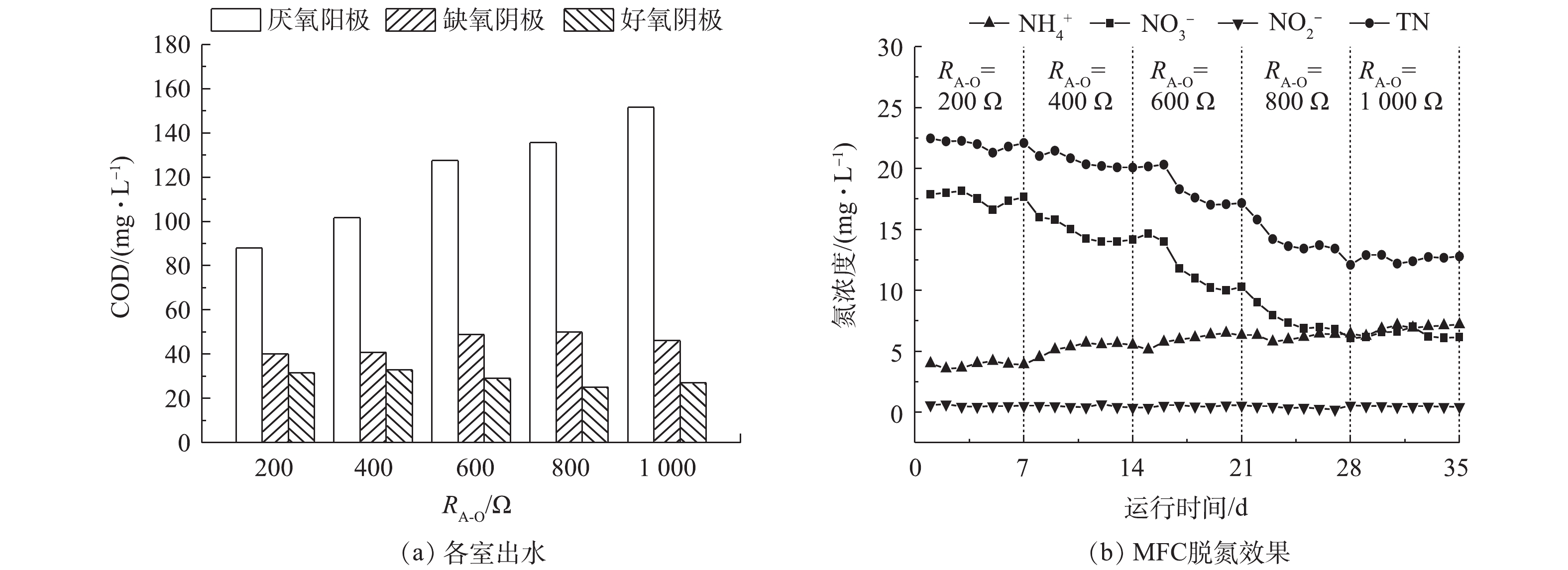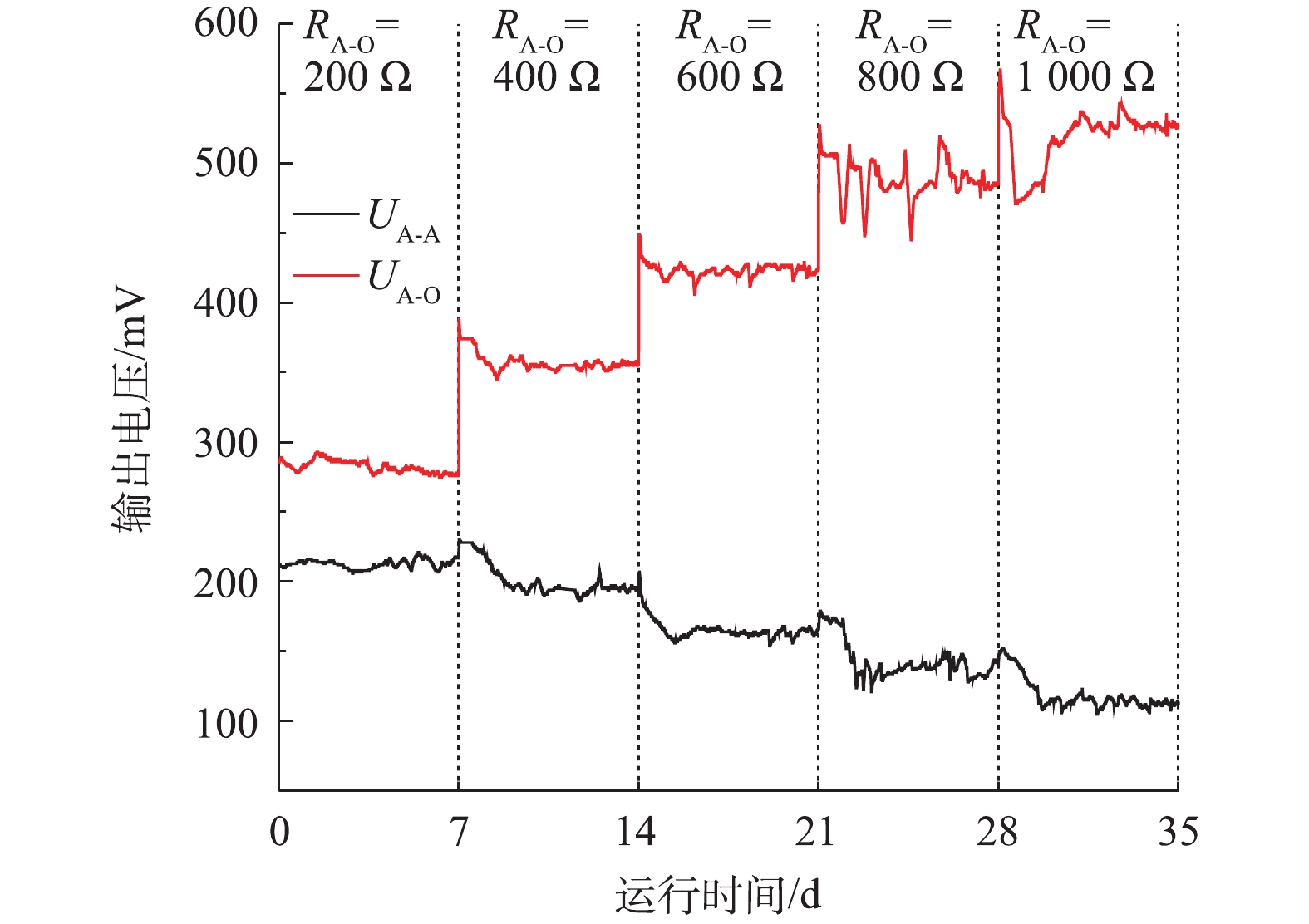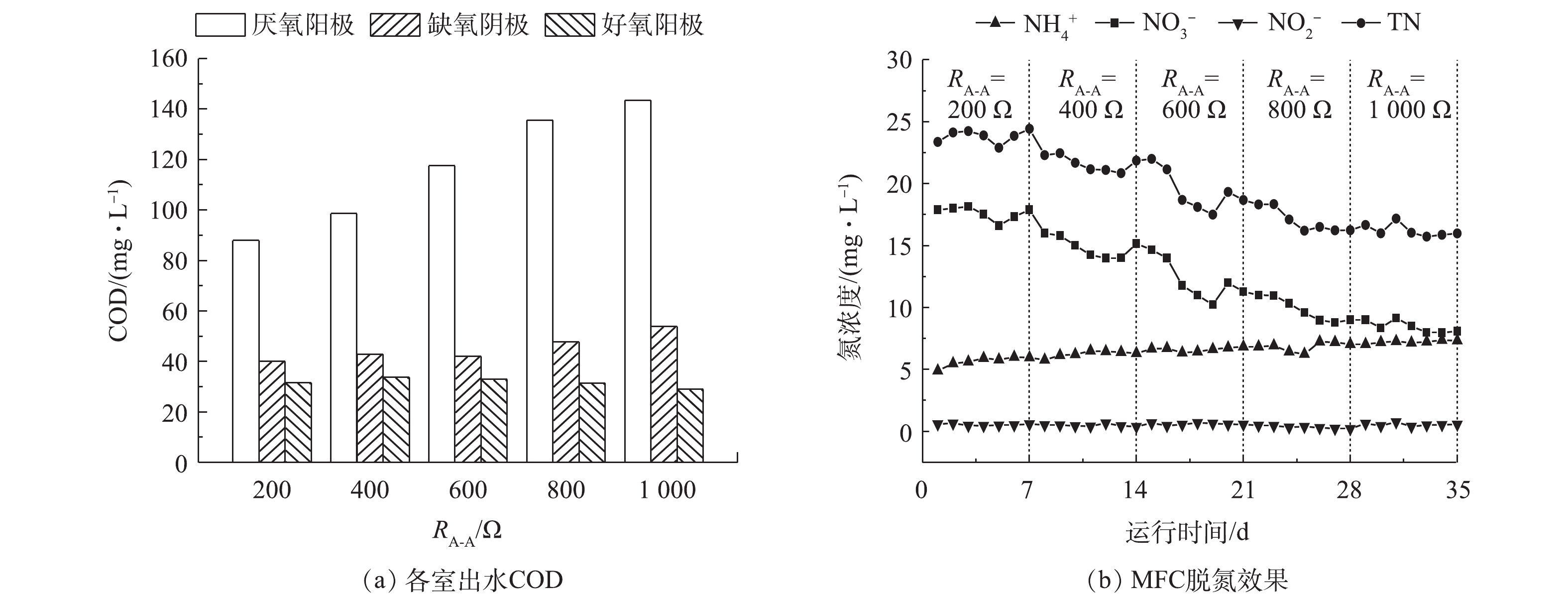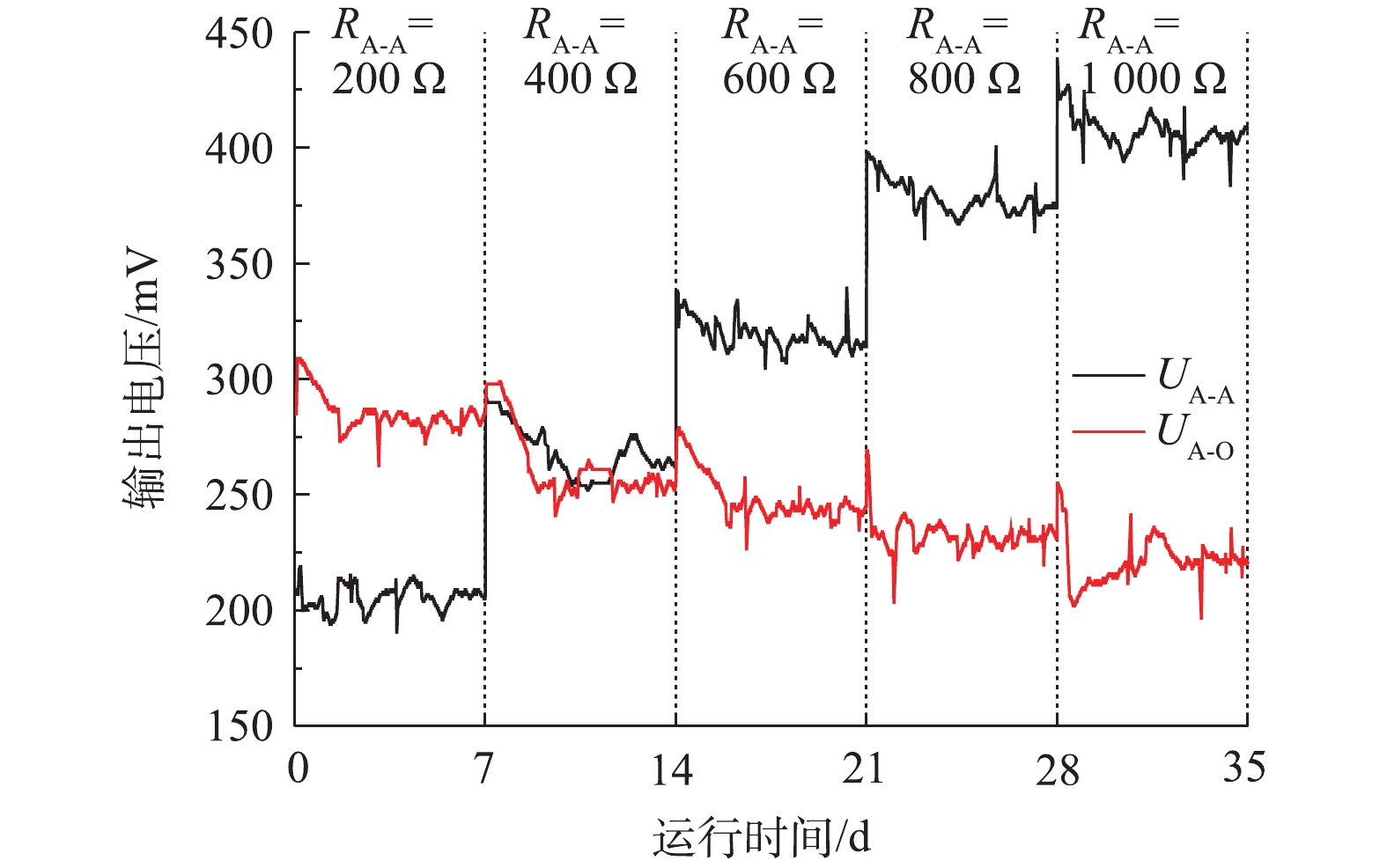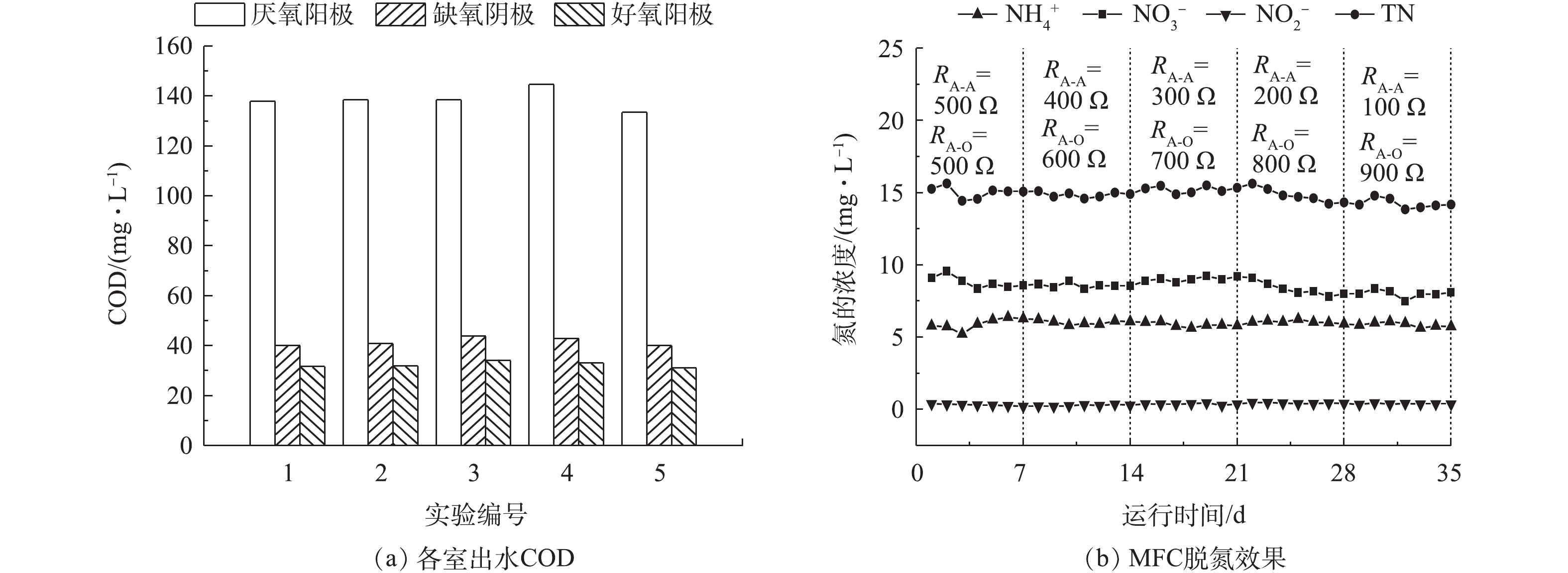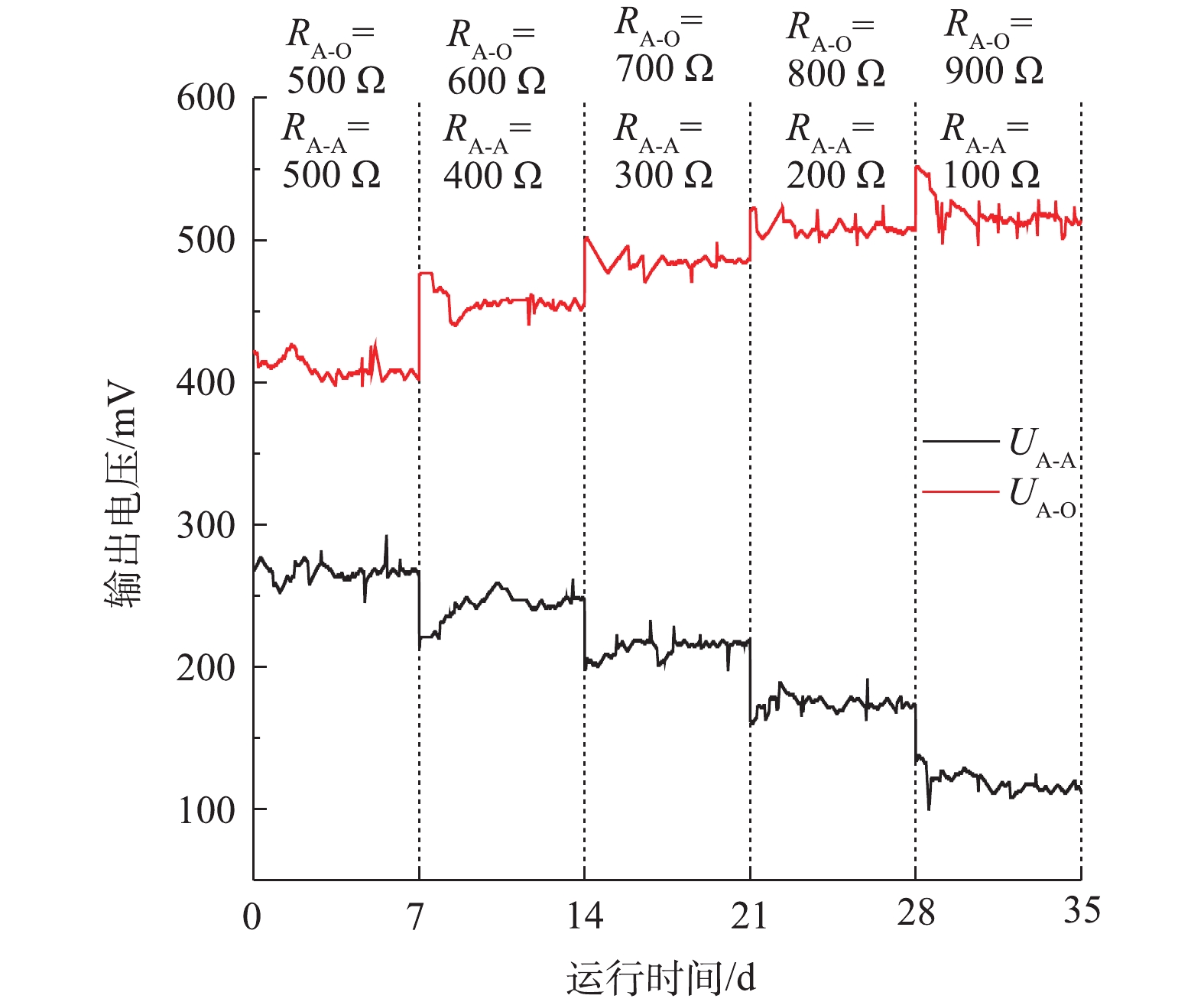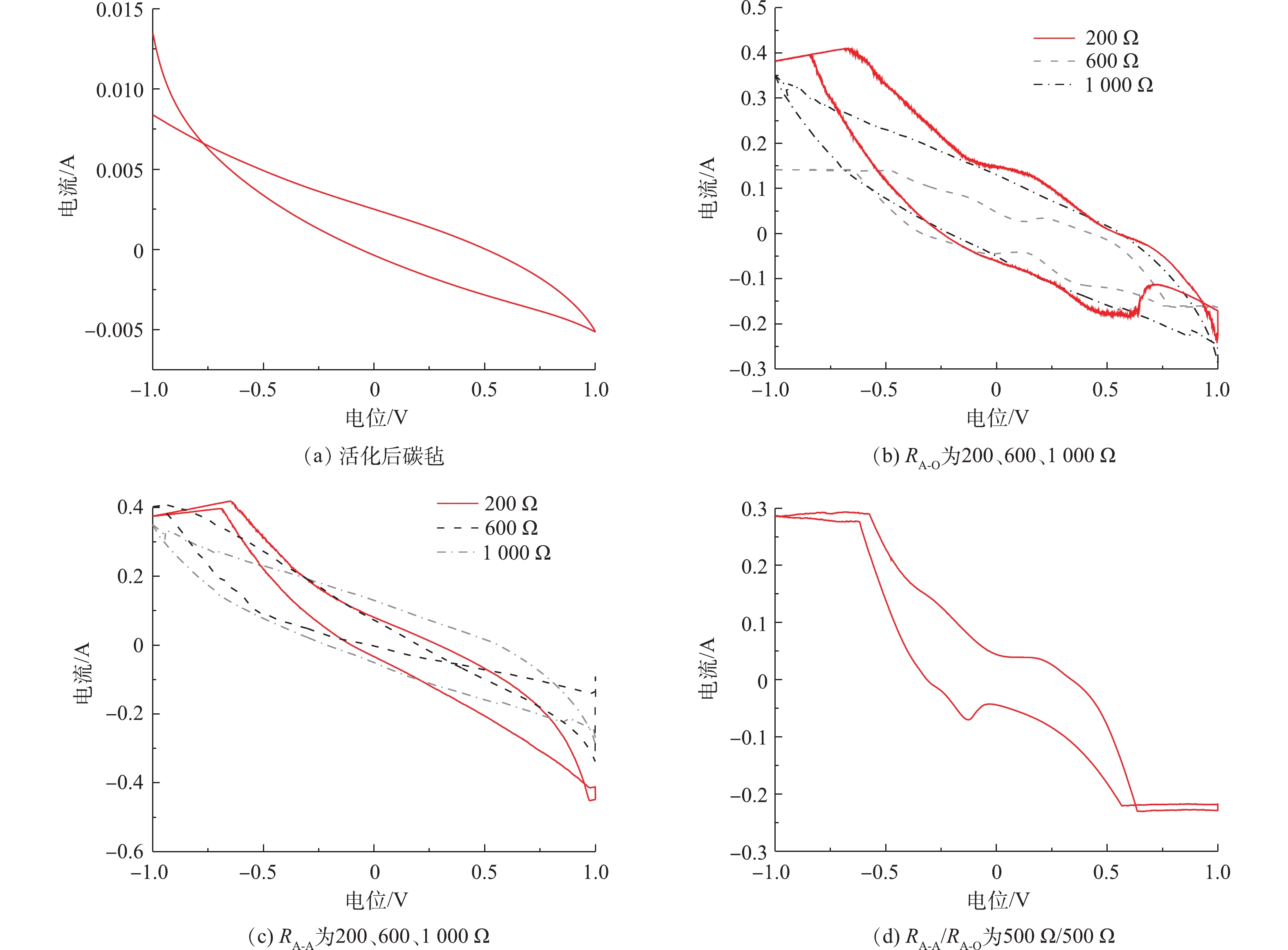-
微生物燃料电池(microbial fuel cells,MFC)是一种通过可产电菌种的代谢作用来降解有机物,并将代谢过程中产生的电子通过外电路传输进而产生电能[1-2]的装置。双阴极MFC可在去除COD的同时、进行硝化和反硝化过程,从而提高了传统MFC的脱氮能力。ZHANG等[3]在传统MFC阳极的两侧添加了好氧和厌氧阴极室,这种复合多室的MFC系统可去除污水中76%的氮。LEE等[4]构建了双阴极MFC,好氧阴极对氨氮的去除率可达97.9%,在缺氧阴极处理硝态氮,其去除率为89.9%。外电阻被认为是影响MFC性能的一项重要因素,增大外阻不但会影响电池产电性能,对电池内有机物的去除也有较大的影响。JANG等[5]的研究表明,在双室MFC中,随外阻的增加,电流和COD去除率均会降低。荣宏伟等[6]构建了阴极硝化和阳极反硝化的双室MFC发现,外阻越小,有机物降解速率越快,TN去除率越高,阳极表面生物膜产电菌的氧化能力越强。这些报道均集中在研究外电阻对双室MFC的影响,但在3室MFC中,外电阻变化是否会有相同的结论尚需进一步的研究。本研究构建了3室MFC,目的在于寻求优化3室MFC脱氮产电性能的组合。该系统的运行方式与传统A2O工艺相似,能同时去除有机物和氮,便于驯化适用于不同阴极的微生物,易与传统污水处理工艺相结合,且较双室MFC产电多。本研究通过变换不同的电阻组合以探明外阻变化对双阴极MFC产电脱氮性能的影响,为进一步提高MFC的脱氮产电性能提供参考。
-
1)材料。MFC接种的菌种来自西安北石桥污水厂二沉池回流污泥。MFC以葡萄糖为唯一碳源,氮源全部由NH4Cl 提供,进水指标为COD 400 mg·L−1、氮含量40 mg·L−1,具体组分为0.425 g·L−1 C6H12O6、0.154 g·L−1 NH4Cl、0.029 g·L−1 KH2PO4、0.014 g·L−1 K2HPO4和微量元素[7],以上试剂均为分析纯。
2)仪器。电化学工作站(上海辰华CHI760E);紫外分光光度计(棱光UV757CRT)。
-
如图1所示,本实验构建了由缺氧室、厌氧室和好氧室组成的3室微生物燃料电池反应器。缺氧室和厌氧室的有效容积均为3 L,顶部加有盖板以保证室腔内的缺氧及厌氧环境,好氧室的容积为4.5 L,无盖。各腔室之间采用nafion117型质子交换膜隔开。电池的电极为20 cm×30 cm×0.5 cm的导电碳毡,做成圆筒状。取回的污泥曝气24 h后接种,接种量为反应器有效容积的30%。
-
MFC采用连续进水方式启动。启动过程中,通过蠕动泵将进水流量控制为8 mL·min−1,内回流比为300%,厌氧阳极与缺氧阴极之间、厌氧阳极与好氧阴极之间均接有200 Ω的电阻箱。模拟污水从厌氧阳极底部进入反应器,发生氧化反应,为2个阴极提供电子。之后流入缺氧阴极,获得电子,发生反硝化反应,去除
${\rm{NO}}_3^ - $ 后,进入好氧阴极,好氧室内发生硝化反应去除${\rm{NH}}_4^ + $ ,硝化液回流至缺氧室,最终处理完成从好氧阴极出水[5],工艺流程如图2所示。好氧阳极室添加微生物填料以提高好氧阴极室的硝化能力[8]。当连续7 d输出电压变化不超过10 mV时,则MFC启动成功。MFC启动成功后,采用流量为8 mL·min−1的连续进水,内回流比300%,温度为(30±0.5) ℃。在以下3种情况下,考察电阻变化对MFC脱氮产电性能的影响。3种电阻变化情况如下:阳极与缺氧阴极间电阻 (RA-A)稳定在200 Ω,阳极与好氧阴极间电阻(RA-O)为200~1 000 Ω;RA-O稳定在200 Ω,RA-A为200~1 000 Ω;总外阻保持为1 000 Ω,调整不同 RA-A/RA-O组合为500 Ω/500 Ω、400 Ω/600 Ω、300 Ω/700 Ω、200 Ω/800 Ω、100 Ω/900 Ω。每组实验运行7 d,各项指标均为系统稳定后测得的平均值。
-
常规水质测试均采用国家标准方法[9]。采用重铬酸钾法测定溶液中COD;采用水杨酸-次氯酸盐分光光度法测定溶液中
${\rm{NH}}_4^ + $ ;采用紫外分光光度法测定溶液中${\rm{NO}}_3^ - $ ;采用N-(1-萘基)-乙二胺光度法测定溶液中${\rm{NO}}_2^ - $ 。利用电化学工作站(上海辰华CHI760E)对MFC阳极碳毡电极上的生物膜进行循环伏安扫描。测试采用三电极体系[10]:铂丝为对电极、Ag/AgCl为参比电极、碳毡为工作电极。电势扫描范围为−1.0~1.0 V,扫描速度为10 mV·s−1。
采用在线监测系统测量电压,每隔5 min记录一次。根据欧姆定律I=U/R计算电流 I,根据式(1)计算功率密度。
式中:P为体积功率密度,mW·m−3;U为电压,V;阳极与缺氧阴极之间、阳极与好氧阴极之间的电压分别记为UA-A和UA-O,mV;V为阳极或阴室有效容积,m3,R为外电阻,Ω。
库仑效率的计算方法[11]见式(2)。
式中:η为库仑效率;F为法拉第常数,取值96 485 C·mol−1;ΔC为阳极进出水COD差或缺氧阴极进出水
${\rm{NO}}_3^ - $ -N浓度差,mg·L−1;M为氧的摩尔质量(取值16 g·mol−1),或氮的摩尔质量(取值14 g·mol−1);n为单位污染物所转移的电子数,在计算厌氧阳极时,n=2,在计算缺氧阴极时,n=5;Q为进水流量,8 mL·min−1。 -
系统运行稳定后,其他运行条件与启动阶段保持完全一致,调整RA-O为200、400、600、800、1 000 Ω,每组运行7 d。RA-A始终为200 Ω。在进水COD为(401.17±1.73) mg·L−1、
${\rm{NH}}_4^ + $ -N为(40.92±1.45) mg·L−1的条件下,双阴极MFC各底物出水浓度如图3所示。由图3(a)可知,电阻越大,阳极COD去除率越低,厌氧阳极出水COD由(87.01±0.15) mg·L−1上升至(151.63±1.09) mg·L−1,与外电阻对双室MFC影响的研究结论[5,10]一致。这主要是因为在较高外阻的条件下,外电路会损耗大量电子,从阳极转移到阴极的电子数就会减少,此外,高外阻条件下底物不易在阳极表面氧化,因此,阳极内消耗的COD减少。
由图3(b)可知,出水
${\rm{NO}}_3^ - $ 由(17.59±0.48) mg·L−1降低至(5.39±0.07) mg·L−1,TN去除率由43.82%提高到60.71%。但在双室MFC中[5],TN的去除率会随着外电阻增大而减小,与本实验结论相反,原因是双室MFC中${\rm{NO}}_3^ - $ 主要通过从阳极获得电子被还原为N2等产物去除,TN去除率会因外电路转移电子的增多而提高;而本实验处于连续进水状态,发生反硝化反应的缺氧室有较高耗氧有机物(以COD计)流入,因此,${\rm{NO}}_3^ - $ 除了能通过从电极获得电子被还原外,还可通过异养反硝化菌(如脱氮小球菌、反硝化假单胞菌等)内源呼吸作用被消耗[11-12]。由图3(a)可知,RA-O越高,厌氧室对COD的利用率越低,则流入缺氧室的耗氧有机物(以COD计)越高,可利用碳源变多使得异养反硝化菌进行无氧呼吸的生化过程增强,${\rm{NO}}_3^ - $ 作为氮源被有效去除[13]。图4反映了输出电压随电阻的变化情况。由图4可知:随着RA-O的增大,UA-O由(285±5) mV升高到(491±4) mV,通过式(1)计算,好氧阴极的功率密度由(90.25±1.29) mW·m−3降低至(66.58±2.98) mW·m−3;UA-A由(212±3) mV降低至(134±3) mV,缺氧阴极的功率密度由(74.91±0.89) mW·m−3降低至(34.57±2.12) mW·m−3;厌氧阳极的功率密度由(411.68±5.39) mW·m−3降低至(288.13±4.21) mW·m−3。以上说明RA-O增大,电池的产电性能变差,与对双室MFC的研究结果[14-15]一致。原因是外阻变大,胞外电子的转移阻力增大,电子的传递速率减缓,则电流减小,同时外电阻的增大会使得电子大部分消耗在运输过程中,改变了电路中电子的分配比,产电性能变差。同时可以观察到,在每次增大RA-O的瞬间,UA-A都会立刻上升5~10 mV。这是由于2个阴极对电子是竞争关系[16],RA-O增大会阻碍电子向好氧阴极的传输,电子流向缺氧阴极,所以UA-A暂时上升。随后由于总外阻增大,电池产电能力减弱,UA-A也开始下降。
由表1可知,缺氧阴极中库仑效率由(1.63±0.02)%降低至(1.28±0.03)%,随RA-A的增大而降低,说明系统通过电极的脱氮能力下降。这是由于缺氧室存在的2种反硝化过程(电极反硝化与生物反硝化)对电子受体
${\rm{NO}}_3^ - $ 是竞争关系[17-18],生物反硝化的增强会抑制${\rm{NO}}_3^ - $ 从电极获取电子的能力,电极反硝化减弱。虽然电极反硝化在RA-O增大的过程中减弱,但总的反硝化过程增强,说明本系统中的反硝化过程由生物反硝化过程主导。 -
将MFC两侧电阻回调至同为200 Ω的状态,运行稳定后,固定RA-O为200 Ω,调整RA-A为200、400、600、800、1 000 Ω,每组运行7 d。在进水的COD为(400.12±3.63) mg·L−1、
${\rm{NH}}_4^ + $ -N为(40.51±2.12) mg·L−1的条件下,双阴极MFC各底物出水浓度如图5所示。由图5可知,在RA-A增大过程中,各个阶段初始的${\rm{NH}}_4^ + $ 浓度均大于前文RA-O增大过程中${\rm{NH}}_4^ + $ 出水浓度。这是由于好氧阴极内${\rm{NH}}_4^ + $ 和电极对O2是竞争关系[16],较大的RA-O会阻碍电子向好氧阴极传输,电极对O2竞争性减弱,硝化细菌可获得更多O2进行硝化反应,因此,较大的RA-O状态下系统会有更高的${\rm{NH}}_4^ + $ 去除率。TN去除率也随着RA-A的增大而升高,说明双阴极MFC中,RA-A和RA-O的增大均能有效提高系统对总氮的去除率。RA-A增大对污染物去除的影响与前文一致。由图6可知:随着RA-A的增大,UA-A由(209±8) mV升高到(409±11) mV,好氧阴极的功率密度由(91.51±1.33) mW·m−3降低至(53.78±2.18) mW·m−3;UA-O由(289±5) mV降低至(225±13) mV,缺氧阴极的功率密度却由(73.85±1.21) mW·m−3降低至 (55.76±5.19) mW·m−3;厌氧阳极的功率密度由(419.97±3.11) mW·m−3降低至(316.39±2.22) mW·m−3。以上说明RA-A的增大使得电池的产电性能变差,且RA-O增大的影响略大于RA-A增大的影响。
由表2可知,缺氧阴极的库仑效率由(1.95±0.01)%降低至(0.67±0.03)%,降幅明显高于RA-O增大时缺氧阴极库仑效率的降幅,说明RA-A增大对电极反硝化的影响大于RA-O增大对电极反硝化的影响。这是由于RA-A增大阻碍了电流向缺氧阴极的传输,
${\rm{NO}}_3^ - $ 从电极获得的电子减少,电极反硝化能力因此减弱。 -
将MFC两侧电阻调整至同为500 Ω,运行稳定后,固定总外阻为1 000 Ω,调整不同RA-A/RA-O组合为500 Ω/500 Ω、400 Ω/600 Ω、300 Ω/700 Ω、200 Ω/800 Ω、100 Ω/900 Ω,实验编号为1~5,每组运行7 d。在进水的COD为(399.1±4.61) mg·L−1、
${\rm{NH}}_4^ + $ -N为(41.08±1.98) mg·L−1的条件下,双阴极MFC各底物的出水浓度如图7所示。由图7(a)和表3可知,总外阻不变,厌氧室出水COD保持在138.6 mg·L−1左右,这说明在固定总外阻的情况下,改变RA-A和RA-O不会影响阳极内有机物氧化产生电子的过程。由表3和图7(b)可知,缺氧阴极的库仑效率由(0.61±0.02)%上升至(1.53±0.03)%,总氮去除率由(62.32±0.77)%上升至(64.41±0.32)%,出水的硝态氮由(8.59±0.97) mg·L−1下降至(7.99±1.02) mg·L−1。其原因是,缺氧室进水COD变化不大,反硝化细菌内源呼吸消耗的${\rm{NO}}_3^ - $ 一定的情况下,RA-A降低,阳极向缺氧阴极转移电子的损耗减少,${\rm{NO}}_3^ - $ 可从电极获得的电子增多,电极反硝化过程增强,TN去除率因此上升,这同双室MFC与外阻关系的结论[5-6]一致。由图8可知,当UA-A由(269±4) mV降低至到(113±8) mV时,好氧阴极的功率密度由(73.62±1.14) mW·m−3降低至(65.23±2.11) mW·m−3;当UA-O由(407±5) mV升高至(516±15) mV时,缺氧阴极的功率密度由(73.62±1.26) mW·m−3降低至(65.23±4.24) mW·m−3;厌氧阳极的功率密度由(304.65±3.67) mW·m−3变为(305.19±1.22) mW·m−3,这说明固定总外阻不影响电池的产电能力。
-
由图9可以看出,空白碳毡没有出现氧化峰,说明碳毡本身不具有氧化性[19]。由图9(b)可知:RA-A固定为200 Ω时,RA-O为200 Ω时,在E=−0.612 V出现电流为1.429×10−2 A的氧化峰;RA-O为600 Ω时,在E=−0.987 V出现电流为6.861×10−3 A的氧化峰;RA-O为1 000 Ω时,在E=−0.479 V出现了电流为1.429×10−3 A的氧化峰。由图9(c)可知:RA-O固定为200 Ω时,RA-O为200 Ω时,在E=−0.649 V出现电流为1.180×10−2 A的氧化峰;RA-O为600 Ω时,在E=−0.938 V出现电流为4.867×10−3 A的氧化峰;RA-O为1 000 Ω时,在E=−0.763 V出现了电流为2.429×10−3 A的氧化峰。由图9(d)可见,总外阻不变,氧化峰的位置基本没有改变(此处只展示RA-A/RA-O为500 Ω/500 Ω的CV图谱),在E=−0.679 V出现电流为5.869×10−4 A的氧化峰。结果显示,外电阻越高,阳极形成的生物膜上产电活性菌的氧化能力越弱,总外阻不变不影响阳极生物膜的氧化性[20]。
-
1)连续进水3室双阴极MFC的TN去除率随总外阻的增大而增大。系统的反硝化过程由生物内源呼吸脱氮过程主导,受缺氧室进水COD影响明显。系统的硝化效果随RA-O的增大而增强,反硝化效果随RA-A的减小而增强。
2)连续进水3室双阴极MFC的产电性能随总外电阻的增大而减弱,输出电压、功率密度和库仑效率均有明显的降低。在总外阻不变的情况下,3室双阴极MFC的产电性能不受RA-O和RA-A的影响。
3)循环伏安扫描结果显示,随着总外阻的增大,阳极表面微生物膜的氧化性减弱。在固定总外阻时,调整RA-A/RA-O不会影响阳极表面微生物膜的氧化性。为了提高双阴极三室MFC的脱氮能力,可在降低总外阻的前提上,采用较低 RA-A与较高 RA-O的外阻组合来实现。
外电阻对双阴极微生物燃料电池脱氮产电性能的影响
Effect of external resistance on denitrification and electricity generation performance of double-cathode microbial fuel cell
-
摘要: 为提高双阴极MFC的脱氮产电性能,构建了双阴极微生物燃料电池系统,考察了连续进水状态下阳极与缺氧阴极间外阻(RA-A)以及阳极与好氧阴极间外阻(RA-O)的变化对系统脱氮产电性能的影响。结果表明:只增大一侧电阻会降低厌氧阳极的库仑效率和功率密度,但能提高系统的脱氮效果;当RA-O由200 Ω增大到1 000 Ω时,TN去除率由43.81%提高到60.71%,当RA-A由200 Ω增大到1 000 Ω时,TN去除率由38.88%提高到61.52%;当总外阻固定在1 000 Ω时,两侧电阻变化不影响阳极的功率密度和库仑效率,其分别保持在305.53 mW·m−3和0.35%左右;电阻组合(RA-A /RA-O)由500 Ω/500 Ω变化为100 Ω/900 Ω,TN去除率由62.32%提高到64.41%;系统的硝化效果随RA-O的增大而增强,反硝化效果随RA-A的减小而增强,总氮去除效果随总外阻的增大而提升。低RA-A与高RA-O的外阻组合能有效提高双阴极三室MFC的脱氮能力。增大总外阻,系统产电性能降低,阳极表面微生物膜氧化性不断减弱,总外阻不变,阳极表面氧化性变化不大。研究探明了外电阻变化对三室双阴极MFC脱氮产电性能的影响,为进一步提高MFC脱氮产电性能提供参考。Abstract: In order to improve the nitrogen removal and electricity generation performance of dual cathode MFC, a dual cathode microbial fuel cell system was built. Under continuous water inflow, the effects of change in the external resistance between the anode and the anoxic cathode (RA-A) and the external resistance between the anode and the aerobic cathode (RA-O) on the nitrogen removal and electricity generation performance of the system were examined. The results showed that when the resistance on one side increased, the coulomb efficiency and power density of the anaerobic anode decreased, but the nitrogen removal effect of the system increased. When RA-O increased from 200 Ω to 1 000 Ω, TN removal rate increased from 43.81% to 60.71%. When RA-A increased from 200 Ω to 1 000 Ω, TN removal rate increased from 38.88% to 61.52%. When the total external resistance was fixed at 1 000 Ω, the changes in the resistance on both sides did not affect the power density and Coulomb efficiency of the anode, which could maintain at about 305.53 mW·m−3 and 0.35%, respectively. The combination of small RA-A and large RA-O could improve the nitrogen removal effect of dual cathode MFC, when the resistance combination (RA-A/RA-O) changed from 500 Ω/500 Ω to 100 Ω/900 Ω, TN removal rate increased from 62.32% to 64.41%. The nitrification effect of the system increased with the increase of RA-O, the denitrification effect increased with the decrease of RA-A, and the total nitrogen removal effect increased with the increase of total external resistance. The external resistance combination of low RA-A and high RA-O could effectively improve the nitrogen removal capacity of the dual cathode three-chamber MFC. Increasing the total external resistance reduced the power generation performance of the system, and weakened the oxidizing ability of the microbial membrane on the anode surface. The total external resistance did not change, then little change in surface oxidation of the anode occurred. This study clarified the effects of change in the external resistance on the nitrogen removal and electricity generation performance of the dual cathode three-chamber MFC, and provided the reference for the further improvement of the nitrogen removal and electricity generation performance of MFC.
-
Key words:
- dual-cathode /
- microbial fuel cells /
- resistance /
- nitrogen removal /
- cyclic voltammetric scanning
-

-
表 1 RA-O增大对产电性能的影响
Table 1. Effect of increasing RA-O on electrical performance
RA-A/Ω 功率密度/(mW·m−3) 库仑效率/% 厌氧阳极 缺氧阴极 好氧阴极 厌氧阳极 缺氧阴极 200 411.68 74.91 90.25 0.49 1.63 400 345.16 64.03 70.81 0.40 1.51 600 303.71 46.48 66.97 0.35 1.36 800 300.80 41.61 65.28 0.32 1.29 1 000 288.13 34.57 64.68 0.30 1.28 表 2 RA-A增大对产电性能的影响
Table 2. Effect of increasing RA-A on electrical performance
RA-A/Ω 功率密度/(mW·m−3) 库仑效率/% 厌氧阳极 缺氧阴极 好氧阴极 厌氧阳极 缺氧阴极 200 419.97 73.85 91.51 0.48 1.95 400 341.47 58.96 73.96 0.40 1.19 600 327.21 56.53 65.61 0.37 0.86 800 320.38 59.51 59.29 0.35 0.72 1 000 316.39 55.76 53.78 0.33 0.67 表 3 总外阻不变不同组合对双阴极MFC产电性能的影响
Table 3. Influence of the combination of total external resistance and invariable resistance onelectricity properties of the dual cathode three-chamber MFC
实验编号 电阻/Ω 功率密度/(mW·m−3) 库仑效率/% RA-A RA-O 厌氧阳极 缺氧阴极 好氧阴极 厌氧阳极 缺氧阴极 1 500 500 304.65 48.24 73.62 0.32 0.61 2 400 600 305.74 51.66 77.35 0.34 0.68 3 300 700 304.62 52.32 75.91 0.34 0.75 4 200 800 309.38 50.46 70.56 0.36 0.95 5 100 900 305.53 52.56 65.23 0.39 1.53 -
[1] 王大维, 李浩然, 冯雅丽, 等. 微生物燃料电池的研究应用进展[J]. 化工进展, 2014, 33(5): 1067-1075. [2] ZHANG Q G, HU J J, LEE D J. Microbial fuel cells as pollutant treatment units: research updates[J]. Bioresource Technology, 2016, 217: 121-128. doi: 10.1016/j.biortech.2016.02.006 [3] ZHANG F, HE Z. Simultaneous nitrification and denitrification on with electricity generation in dual-cathode microbial fuel cells[J]. Chemistry Technology Biotechnology, 2012, 87(1): 153-159. doi: 10.1002/jctb.2700 [4] LEE K Y, RYU W S, CHO S I, et al. Comparative study on power generation of dual-cathode microbial fuel cell according to polarization methods[J]. Water Research, 2015, 84: 43-48. doi: 10.1016/j.watres.2015.07.001 [5] JANG J K, PHAM T H, CHANG I S. Construction and operation of a novel mediator and membra-less microbial fuel cell[J]. Process Biochemistry, 2004, 39(8): 1007-1012. doi: 10.1016/S0032-9592(03)00203-6 [6] 荣宏伟, 王佳, 储昭瑞, 等. 外阻对双室微生物燃料电池性能的影响[J]. 水处理技术, 2019, 45(1): 46-50. [7] 刘昌强, 吴俊奇, 崔勇, 等. 多段式接触氧化法处理城市污水实验研究[J]. 水处理技术, 2019, 45(5): 89-93. [8] 李晶, 宋箭, 伍昌年, 等. 倒置A2/O-动态膜生物反应器活性污泥培养和启动实验研究[J]. 应用化工, 2014, 43(9): 1572-1575. [9] 国家环境保护总局. 水和废水监测分析方法[M]. 4版. 北京: 中国环境科学出版社, 2012. [10] LOGAN B E, HAMELERS B, ROZENDAL R, et al. Microbial fuel cells: Methodology and technology[J]. Environmental Science and Technology, 2006, 40(17): 5212-5217. doi: 10.1021/es060394f [11] OON Y S, ONG S A, HO L N, et al. Long-term operation of double chambered microbial fuel cell for bio-electro denitrification[J]. Bioprocess & Biosystems Engineering, 2016, 39(6): 893-900. [12] KIM J R, ZUO Y, REGAN J M, et al. Analysis of ammonia loss mechanisms in microbial fuel cells treating animal wastewater[J]. Biotechnology and Bioengineering, 2008, 99(5): 1120-1127. doi: 10.1002/bit.21687 [13] 高美云, 刘兴国, 曾宪磊, 等. 有机碳对养殖池塘沉积物种反硝化、厌氧氨氧化的影响[J]. 环境工程学报, 2018, 12(1): 49-56. doi: 10.12030/j.cjee.201705137 [14] SIVAKUMAR M, PANDIT A B. Wastewater treatment: A novel energy efficient hydrodynamic avital technique[J]. Ultrasonic Sonochemistry, 2002, 9(3): 123-131. doi: 10.1016/S1350-4177(01)00122-5 [15] 张培远, 刘中良, 侯俊先. 外阻对微生物燃料电池性能的影响[J]. 工程热物理学报, 2012, 33(10): 1777-1780. [16] 崔心水, 赵剑强, 薛腾, 等. 微生物燃料电池同步硝化反硝化脱氮产电研究[J]. 应用化工, 2018, 47(4): 646-650. doi: 10.3969/j.issn.1671-3206.2018.04.004 [17] 李金涛, 张少辉. 反硝化微生物燃料电池的基础研究[J]. 中国环境科学, 2012, 32(4): 617-622. doi: 10.3969/j.issn.1000-6923.2012.04.007 [18] 梁鹏, 张玲, 黄霞, 等. 双筒型微生物燃料电池生物阴极反硝化研究[J]. 环境科学, 2010, 31(8): 1932-1936. [19] ZHANG L X, ZHOU S G, ZHUANG L, et al. Microbial fuel cell based on klebsiella pneumoniae biofilm[J]. Electrochemistry Communications, 2008, 10(10): 1641-1643. doi: 10.1016/j.elecom.2008.08.030 [20] CAO X X, HUANG X, BOON N, et al. Electricity generation by an enriched phototrophic consortium in a microbial fuel cell[J]. Electrochemistry Communications, 2008, 10(9): 1392-1395. doi: 10.1016/j.elecom.2008.07.008 -



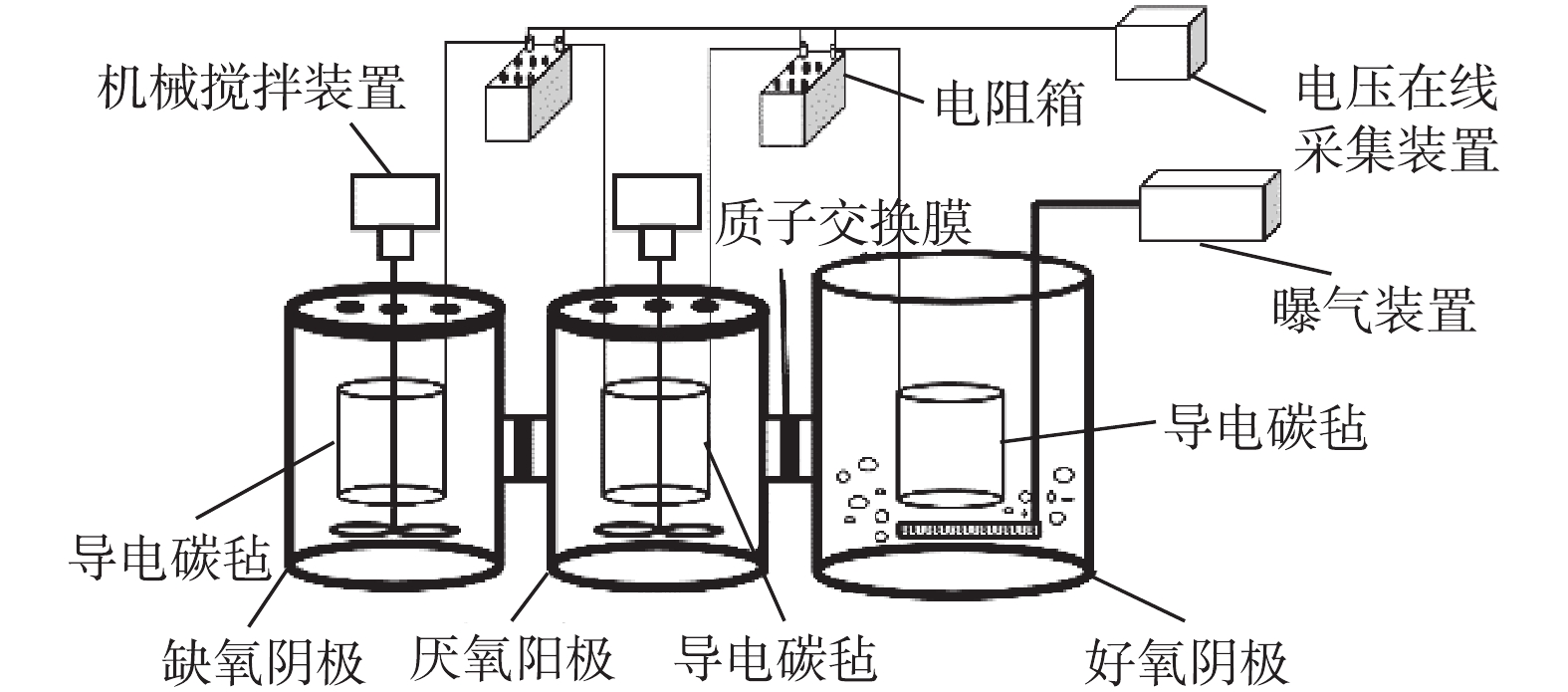
 下载:
下载:

